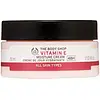What's inside
What's inside
 Key Ingredients
Key Ingredients

 Benefits
Benefits

 Concerns
Concerns

 Ingredients Side-by-side
Ingredients Side-by-side

Water
Skin ConditioningIsopropyl Palmitate
EmollientGlycerin
HumectantButylene Glycol
HumectantCetyl Alcohol
EmollientGlyceryl Stearate
EmollientPEG-100 Stearate
Cetyl Esters
EmollientMyristyl Myristate
EmollientPhenoxyethanol
PreservativeCaprylyl Glycol
EmollientTocopheryl Acetate
AntioxidantCarbomer
Emulsion StabilisingRubus Idaeus Seed Oil
EmollientParfum
MaskingSodium Stearoyl Glutamate
CleansingTrisodium Ethylenediamine Disuccinate
Sodium Hydroxide
BufferingSodium Hyaluronate
HumectantBenzyl Benzoate
AntimicrobialBenzyl Alcohol
PerfumingGeraniol
PerfumingLinalool
PerfumingLimonene
PerfumingHydroxycitronellal
PerfumingAlpha-Isomethyl Ionone
PerfumingCI 14700
Cosmetic ColorantCI 19140
Cosmetic ColorantWater, Isopropyl Palmitate, Glycerin, Butylene Glycol, Cetyl Alcohol, Glyceryl Stearate, PEG-100 Stearate, Cetyl Esters, Myristyl Myristate, Phenoxyethanol, Caprylyl Glycol, Tocopheryl Acetate, Carbomer, Rubus Idaeus Seed Oil, Parfum, Sodium Stearoyl Glutamate, Trisodium Ethylenediamine Disuccinate, Sodium Hydroxide, Sodium Hyaluronate, Benzyl Benzoate, Benzyl Alcohol, Geraniol, Linalool, Limonene, Hydroxycitronellal, Alpha-Isomethyl Ionone, CI 14700, CI 19140
Water
Skin ConditioningAvena Sativa Kernel Extract
AbrasiveDicaprylyl Carbonate
EmollientGlycerin
HumectantGlyceryl Glucoside
HumectantButylene Glycol
HumectantTrehalose
HumectantSaccharide Isomerate
HumectantUrsolic Acid
MaskingAminobutyric Acid
Pentylene Glycol
Skin ConditioningAllantoin
Skin ConditioningCholesterol
EmollientHydrogenated Lecithin
EmulsifyingMadecassoside
AntioxidantPolyacrylate-13
Polyisobutene
Polysorbate 20
EmulsifyingGlyceryl Stearate
EmollientSucrose Distearate
EmollientPropylene Glycol
HumectantPhenoxyethanol
PreservativeCeramide NP
Skin ConditioningCeramide EOP
Skin ConditioningCeramide Ns
Skin ConditioningCeramide As
Skin ConditioningCeramide AP
Skin ConditioningTriethanolamine
BufferingEthylhexylglycerin
Skin ConditioningCitric Acid
BufferingSodium Citrate
BufferingCarbomer
Emulsion StabilisingTrisodium Ethylenediamine Disuccinate
Water, Avena Sativa Kernel Extract, Dicaprylyl Carbonate, Glycerin, Glyceryl Glucoside, Butylene Glycol, Trehalose, Saccharide Isomerate, Ursolic Acid, Aminobutyric Acid, Pentylene Glycol, Allantoin, Cholesterol, Hydrogenated Lecithin, Madecassoside, Polyacrylate-13, Polyisobutene, Polysorbate 20, Glyceryl Stearate, Sucrose Distearate, Propylene Glycol, Phenoxyethanol, Ceramide NP, Ceramide EOP, Ceramide Ns, Ceramide As, Ceramide AP, Triethanolamine, Ethylhexylglycerin, Citric Acid, Sodium Citrate, Carbomer, Trisodium Ethylenediamine Disuccinate
 Reviews
Reviews

Ingredients Explained
These ingredients are found in both products.
Ingredients higher up in an ingredient list are typically present in a larger amount.
Butylene Glycol (or BG) is used within cosmetic products for a few different reasons:
Overall, Butylene Glycol is a safe and well-rounded ingredient that works well with other ingredients.
Though this ingredient works well with most skin types, some people with sensitive skin may experience a reaction such as allergic rashes, closed comedones, or itchiness.
Learn more about Butylene GlycolCarbomer is a polymer of acrylic acid. Its main role is to create a gel consistency.
A high amount of carbomer can cause pilling or balling up of products. Don't worry, most products contain 1% or less of carbomer.
Glycerin is already naturally found in your skin. It helps moisturize and protect your skin.
A study from 2016 found glycerin to be more effective as a humectant than AHAs and hyaluronic acid.
As a humectant, it helps the skin stay hydrated by pulling moisture to your skin. The low molecular weight of glycerin allows it to pull moisture into the deeper layers of your skin.
Hydrated skin improves your skin barrier; Your skin barrier helps protect against irritants and bacteria.
Glycerin has also been found to have antimicrobial and antiviral properties. Due to these properties, glycerin is often used in wound and burn treatments.
In cosmetics, glycerin is usually derived from plants such as soybean or palm. However, it can also be sourced from animals, such as tallow or animal fat.
This ingredient is organic, colorless, odorless, and non-toxic.
Glycerin is the name for this ingredient in American English. British English uses Glycerol/Glycerine.
Learn more about GlycerinGlyceryl Stearate is a mix of glycerin and stearic acid.
It is used to stabilize the mixing of water and oil ingredients. By preventing these ingredients from separating, it can help elongate shelf life. It can also help thicken the product's texture.
As an emollient, it helps soften skin and supports barrier-replenishing ingredients.
In cosmetics, Glyceryl Stearate is often made from vegetable oils or synthetically produced.
This ingredient may not be fungal-acne safe
Fun fact: The human body also creates Glyceryl Stearate naturally.
Learn more about Glyceryl StearatePhenoxyethanol is a preservative that has germicide, antimicrobial, and aromatic properties. Studies show that phenoxyethanol can prevent microbial growth. By itself, it has a scent that is similar to that of a rose.
It's often used in formulations along with Caprylyl Glycol to preserve the shelf life of products.
Trisodium Ethylenediamine Disuccinate is used to help stabilize a product.
It is a chelating agent, meaning it helps prevent metal ions from binding to other ingredients. This prevents unwanted reactions in products. Metal ions can come into a product via the water ingredient. They are found in trace amounts and are not known to be harmful.
Water. It's the most common cosmetic ingredient of all. You'll usually see it at the top of ingredient lists, meaning that it makes up the largest part of the product.
So why is it so popular? Water most often acts as a solvent - this means that it helps dissolve other ingredients into the formulation.
You'll also recognize water as that liquid we all need to stay alive. If you see this, drink a glass of water. Stay hydrated!
Learn more about Water